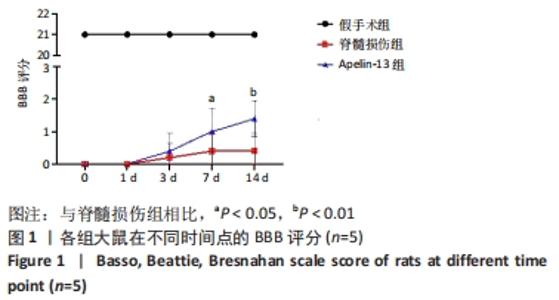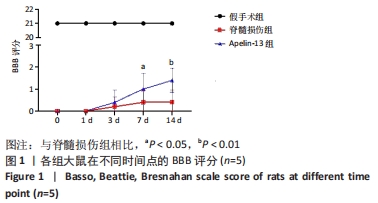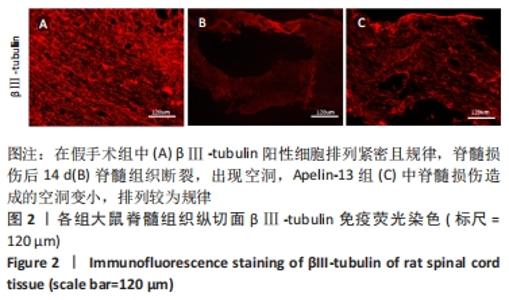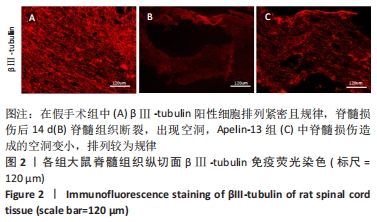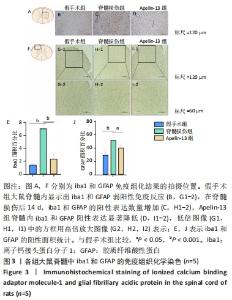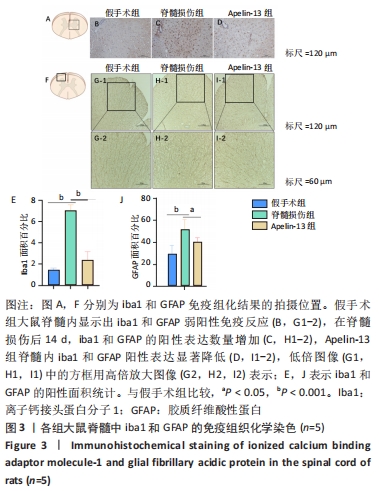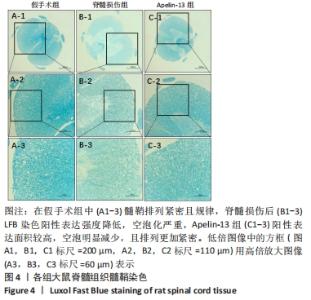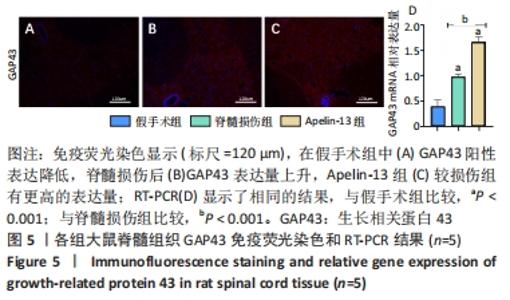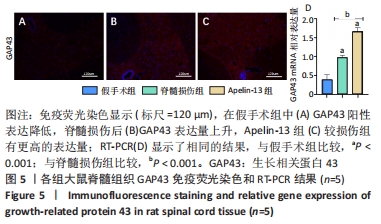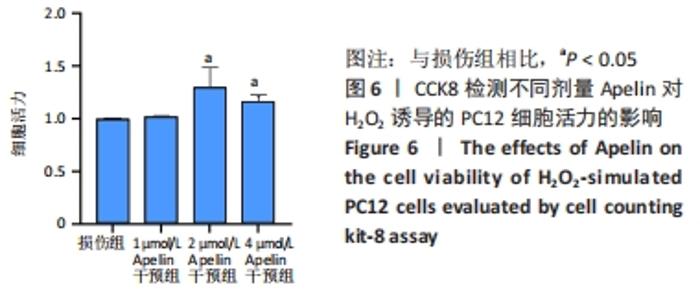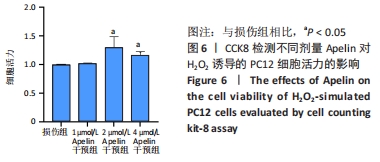Chinese Journal of Tissue Engineering Research ›› 2023, Vol. 27 ›› Issue (11): 1744-1749.doi: 10.12307/2022.1018
Previous Articles Next Articles
Apelin promotes locomotor recovery and spinal cord morphology repair in rats with spinal cord injury
Liu Qing1, Wang Xiao1, Gu Chengxu1, Guo Qixuan1, Li Xikai1, Zhang Luping1, Huang Fei1, 2
- 1Department of Anatomy, Basic Medical University, Yantai 256699, Shandong Province, China; 2School of Health and Life Sciences, University of Health and Rehabilitation Science, Qingdao 266071, Shandong Province, China
-
Received:2022-01-30Accepted:2022-03-12Online:2023-04-18Published:2022-09-27 -
Contact:Huang Fei, MD, Professor, Department of Anatomy, Basic Medical University, Yantai 256699, Shandong Province, China; School of Health and Life Sciences, University of Health and Rehabilitation Science, Qingdao 266071, Shandong Province, China Zhang Luping, MD, Associate professor, Department of Anatomy, Basic Medical University, Yantai 256699, Shandong Province, China -
About author:Liu Qing, Master candidate, Department of Anatomy, Basic Medical University, Yantai 256699, Shandong Province, China -
Supported by:the National Natural Science Foundation of China, Nos. 81870985 and 81171142 (to HF)
CLC Number:
Cite this article
Liu Qing, Wang Xiao, Gu Chengxu, Guo Qixuan, Li Xikai, Zhang Luping, Huang Fei. Apelin promotes locomotor recovery and spinal cord morphology repair in rats with spinal cord injury[J]. Chinese Journal of Tissue Engineering Research, 2023, 27(11): 1744-1749.
share this article
Add to citation manager EndNote|Reference Manager|ProCite|BibTeX|RefWorks
| [1] YI XM, LI M, CHEN YD, et al. Neuregulin1 impacting bone marrow mesenchymal stem cell migration is conducive to functional recovery following spinal cord injury. Mol Med Rep. 2019;20(1):41-48. [2] ZHOU X, HE X, REN Y. Function of microglia and macrophages in secondary damage after spinal cord injury. Neural Regen Res. 2014;9(20):1787-1795. [3] LI C, JIAO G, WU W, et al. Exosomes from Bone Marrow Mesenchymal Stem Cells Inhibit Neuronal Apoptosis and Promote Motor Function Recovery via the Wnt/beta-catenin Signaling Pathway. Cell Transplant. 2019;28(11):1373-1383. [4] CODELUPPI S, SVENSSON CI, HEFFERAN MP, et al. The Rheb-mTOR pathway is upregulated in reactive astrocytes of the injured spinal cord. J Neurosci. 2009; 29(4):1093-1104. [5] CHOI SJ, KIM JK, KIM HK, et al. 2,4-Di-tert-butylphenol from sweet potato protects against oxidative stress in PC12 cells and in mice. J Med Food. 2013;16(11):977-983. [6] TATEMOTO K, HOSOYA M, HABATA Y, et al. Isolation and characterization of a novel endogenous peptide ligand for the human apj receptor. Biochem Biophys Res Commun. 1998;251(2):471-476. [7] LIM R, BARKER G, RILEY C, et al. Apelin is decreased with human preterm and term labor and regulates prolabor mediators in human primary amnion cells.Reprod Sci. 2013;20(8):957-967. [8] ASHLEY EA, POWERS J, CHEN M, et al. The endogenous peptide apelin potently improves cardiac contractility and reduces cardiac loading in vivo. Cardiovasc Res. 2005;65(1):73-82. [9] LUO H, HAN L, XU J.Apelin/APJ system: A novel promising target for neurodegenerative diseases. J Cell Physiol. 2020;235(2):638-657. [10] DUAN J, CUI J, YANG Z, et al. Neuroprotective effect of Apelin 13 on ischemic stroke by activating AMPK/GSK-3β/Nrf2 signaling.J Neuroinflammation. 2019; 16(1):24. [11] OLSON HE, ROONEY GE, GROSS L, et al. Neural stem cell– and schwann cell–loaded biodegradable polymer scaffolds support axonal regeneration in the transected spinal cord. Tissue Eng Part A. 2009;15(7):1797-805. [12] CHIO CC, LIN JW, CHANG MW, et al. Therapeutic evaluation of etanercept in a model of traumatic brain injury. J Neurochem. 2010;115(4):921-929. [13] HE S, WANG Z, LI Y, et al. MicroRNA-92a-3p enhances functional recovery and suppresses apoptosis after spinal cord injury via targeting phosphatase and tensin homolog. Biosci Rep. 2020;40(5):BSR20192743. [14] HE Y, LI M, WUJISIGULENG, LV B, et al. Zhenbao Pill reduces Treg cell proportion in acute spinal cord injury rats by regulating TUG1/miR-214/HSP27 axis. Biosci Rep. 2018;38(6):BSR20180895. [15] ZHAN G, SERRANO F, FENIK P, et al. NADPH oxidase mediates hypersomnolence and brain oxidative injury in a murine model of sleep apnea. Am J Respir Crit Care Med. 2005;172(7):921-929. [16] ROCHA DN, BRITES P, FONSECA C, et al. Poly(trimethylene carbonate-co-epsilon-caprolactone) promotes axonal growth. PLoS One. 2014;9(2):e88593. [17] YIN H, TIAN H, LI Q, et al. Jia-Ji Electro-Acupuncture Improves Locomotor Function With Spinal Cord Injury by Regulation of Autophagy Flux and Inhibition of Necroptosis. Front Neurosci. 2021;14:616864. [18] XU W, LI T, GAO L, et al. Apelin-13/APJ system attenuates early brain injury via suppression of endoplasmic reticulum stress-associated TXNIP/NLRP3 inflammasome activation and oxidative stress in a AMPK-dependent manner after subarachnoid hemorrhage in rats. J Neuroinflammation. 2019;16(1):247. [19] LIU Y, ZHANG T, WANG Y, et al. Apelin-13 attenuates early brain injury following subarachnoid hemorrhage via suppressing neuronal apoptosis through the GLP-1R/PI3K/Akt signaling.Biochem Biophys Res Commun. 2019;513(1):105-111. [20] BAO HJ, ZHANG L, HAN WC, et al. Apelin-13 attenuates traumatic brain injury-induced damage by suppressing autophagy. Neurochem Res. 2015;40(1):89-97. [21] CHEN D, LEE J, GU X, et al. Intranasal delivery of Apelin-13 is neuroprotective and promotes angiogenesis after ischemic stroke in mice. ASN Neuro. 2015;7(5): 1759091415605114. [22] AMINYAVARI S, ZAHMATKESH M, KHODAGHOLI F,et al. Anxiolytic impact of Apelin-13 in a rat model of Alzheimer’s disease: Involvement of glucocorticoid receptor and FKBP5. Peptides. 2019;118:170102. [23] LUO H, XIANG Y, QU X, et al. Apelin-13 Suppresses Neuroinflammation Against Cognitive Deficit in a Streptozotocin-Induced Rat Model of Alzheimer’s Disease Through Activation of BDNF-TrkB Signaling Pathway. Front Pharmacol. 2019;10:395. [24] ZHU J, DOU S, JIANG Y, et al. Apelin-13 protects dopaminergic neurons in MPTP-induced Parkinson’s disease model mice through inhibiting endoplasmic reticulum stress and promoting autophagy. Brain Res. 2019;1715:203-212. [25] PATIL V, O’CONNELL E, QUINLAN LR, et al. A robust platform for high-throughput screening of therapeutic strategies for acute and chronic spinal cord injury. iScience. 2021;24(3):102182. [26] LI X, GUO Q, YE Z, et al. PPAR gamma Prevents Neuropathic Pain by Down-Regulating CX3CR1 and Attenuating M1 Activation of Microglia in the Spinal Cord of Rats Using a Sciatic Chronic Constriction Injury Model. Front Neurosci. 2021;15:620525. [27] HUANG SQ, TANG CL, SUN SQ, et al. Demyelination initiated by oligodendrocyte apoptosis through enhancing endoplasmic reticulum-mitochondria interactions and Id2 expression after compressed spinal cord injury in rats.CNS Neurosci Ther. 2014;20(1):20-31. [28] WALKER MR, ZHONG J, WASPE AC, et al. Acute MR-Guided High-Intensity Focused Ultrasound Lesion Assessment Using Diffusion-Weighted Imaging and Histological Analysis. Front Neurol. 2019;10:1069. [29] ZHANG H, WU F, KONG X, et al. Nerve growth factor improves functional recovery by inhibiting endoplasmic reticulum stress-induced neuronal apoptosis in rats with spinal cord injury. J Transl Med. 2014;12:130. [30] HUA XY, QIU YQ, WANG M, et al. Enhancement of Contralesional Motor Control Promotes Locomotor Recovery after Unilateral Brain Lesion. Sci Rep. 2016;6:18784. [31] CHIANG JH, CHENG WS, HOOD L, et al. An epigenetic biomarker panel for glioblastoma multiforme personalized medicine through DNA methylation analysis of human embryonic stem cell-like signature. OMICS. 2014;18(5):310-323. [32] WU Z, LU Z, OU J, et al. Inflammatory response and oxidative stress attenuated by sulfiredoxin1 in neuronlike cells depends on nuclear factor erythroid2related factor 2. Mol Med Rep. 2020;22(6):4734-4742. [33] YUNJUN ZOU YJ, WANG B , FU W, et al. Apelin-13 Protects PC12 Cells from Corticosterone-Induced Apoptosis Through PI3K and ERKs Activation. Neurochem Res. 2016;41(7):1635-1644. [34] FOROUGHI K, KHAKSARI M, RAHMATI M, et al. Apelin-13 Protects PC12 Cells Against Methamphetamine-Induced Oxidative Stress, Autophagy and Apoptosis. Neurochem Res. 2019;44(9):2103-2112. [35] WALLER JD, MCNEILL EH, ZHONG F, et al. Plasma Apelin Unchanged With Acute Exercise Insulin Sensitization. J Sports Sci Med. 2019;18(3):537-543. |
| [1] | Fang Xingyan, Tian Zhenli, Zhao Zheyi, Wen Ping, Xie Tingting. Effects of sodium arsenite on human umbilical vein endothelial cell injury and sphingosine kinases 1/sphingosine 1-phosphate signaling axis [J]. Chinese Journal of Tissue Engineering Research, 2023, 27(在线): 1-7. |
| [2] | Tang Liang, Li Xiheng, Niu Ruijuan, Li Xinyue, Zou Xinying, Mao Tianjiao, Li Jiang. Naringin regulates the function of RAW264.7 macrophages to affect the osteogenic differentiation of MC-3T3-E1 cells [J]. Chinese Journal of Tissue Engineering Research, 2023, 27(8): 1205-1210. |
| [3] | Yang Jiujie, Li Zhi, Wang Shujie, Tian Ye, Zhao Wei. Intraoperative neurophysiological monitoring of functional changes following durotomy with decompression for acute spinal cord injury [J]. Chinese Journal of Tissue Engineering Research, 2023, 27(8): 1232-1236. |
| [4] | Liang Jiaqi, Liu Hengxu, Yang Jinxin, Yang Yi, Deng Xuhui, Tan Mingjian, Luo Jiong. Health benefit relationship between exercise and intestinal bacteria [J]. Chinese Journal of Tissue Engineering Research, 2023, 27(8): 1292-1299. |
| [5] | Gao Yu, Han Jiahui, Ge Xin. Immunoinflammatory microenvironment after spinal cord ischemia-reperfusion injury [J]. Chinese Journal of Tissue Engineering Research, 2023, 27(8): 1300-1305. |
| [6] | Wang Min, Yin Xiushan, Wang Yingxi, Zhang Yan, Zhao Long, Xia Shuyue. Inhalation of bone marrow mesenchymal stem cells-derived exosomes alleviates inflammatory injury in chronic obstructive pulmonary disease [J]. Chinese Journal of Tissue Engineering Research, 2023, 27(6): 827-834. |
| [7] | Hao Liufang, Duan Hongmei, Wang Zijue, Hao Fei, Hao Peng, Zhao Wen, Gao Yudan, Yang Zhaoyang, Li Xiaoguang. Spatiotemporal dynamic changes of ependymal cells after spinal cord injury in transgenic mice [J]. Chinese Journal of Tissue Engineering Research, 2023, 27(6): 883-889. |
| [8] | Li Xiaoyin, Yang Xiaoqing, Chen Shulian, Li Zhengchao, Wang Ziqi, Song Zhen, Zhu Daren, Chen Xuyi. Collagen/silk fibroin scaffold combined with neural stem cells in the treatment of traumatic spinal cord injury [J]. Chinese Journal of Tissue Engineering Research, 2023, 27(6): 890-896. |
| [9] | Zhang Qijian, Xu Ximing. Acquisition and application of ectodermal mesenchymal stem cells [J]. Chinese Journal of Tissue Engineering Research, 2023, 27(6): 928-934. |
| [10] | Li Zhichao, Tan Guoqing, Su Hui, Xu Zhanwang, Xue Haipeng. Regulatory role of non-coding RNAs as potential therapeutic targets in spinal cord injury [J]. Chinese Journal of Tissue Engineering Research, 2023, 27(5): 758-764. |
| [11] | Chen Guodong, Zheng Meiyan, Zhang Peng, Wang Zhenchao, Jin Lixin. Changes in sensory neurons and astrocytes and the expression of interleukin 1beta and glial fibrillary acidic protein in the rat spinal cord after selective dorsal rhizotomy [J]. Chinese Journal of Tissue Engineering Research, 2023, 27(5): 726-731. |
| [12] | Tao Xin, Xu Yi, Song Zhiwen, Liu Jinbo. Hippo signaling pathway in the regulation of spinal cord injury [J]. Chinese Journal of Tissue Engineering Research, 2023, 27(4): 619-625. |
| [13] | Zhang Lichen, Chen Liang, Gu Yong. Inorganic ion bionic periosteum regulates immune microenvironment to promote bone repair [J]. Chinese Journal of Tissue Engineering Research, 2023, 27(3): 346-353. |
| [14] | Zhao Feng, Fan Shaoqing, Cheng Xiaoyan, Li Xiaona, Li Changsheng, Ma Haojie. miR-132-3p targets and modulates Ptch1 to reduce neuropathic pain in mice with chronic constriction injury [J]. Chinese Journal of Tissue Engineering Research, 2023, 27(2): 230-236. |
| [15] | Liu Gang, Deng Bowen, Jiang Shengyuan, Xu Lin, Fan Xiao, Tao Jingwei, Zhang Houjun, He Feng, Zhao Yi, Mu Xiaohong. Tetramethylpyrazine improves hemorheological indexes in rats with complete spinal cord transection: a dynamic observation [J]. Chinese Journal of Tissue Engineering Research, 2023, 27(2): 282-286. |
| Viewed | ||||||
|
Full text |
|
|||||
|
Abstract |
|
|||||
